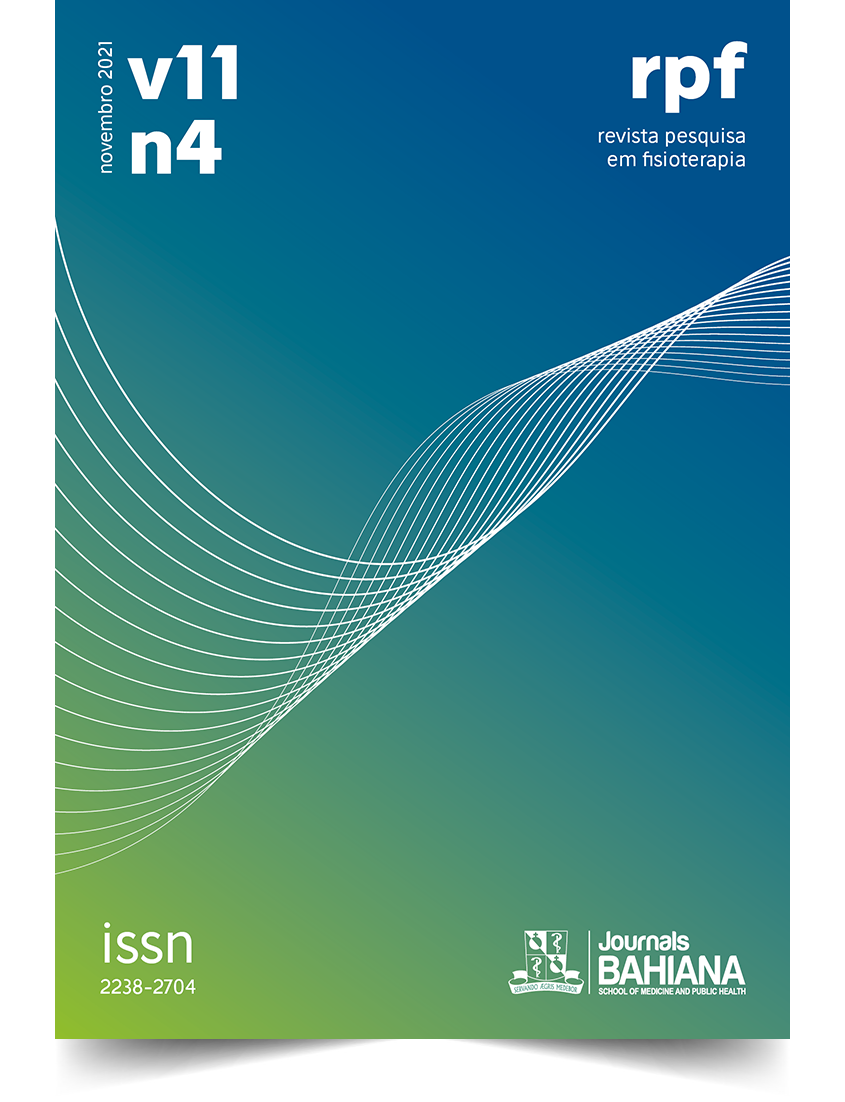Impacto da acessibilidade na adesão ao tratamento fisioterapêutico de pessoas convivendo com paraparesia espástica tropical: estudo qualitativo
DOI:
https://doi.org/10.17267/2238-2704rpf.v11i4.4152Palavras-chave:
Acessibilidade, Adesão ao tratamento, HAM/TSP, Fisioterapia, Pesquisa qualitativaResumo
INTRODUÇÃO: A Paraparesia Espástica Tropical / Mielopatia Associada ao HTLV-1 (HAM/TSP) apresenta alterações crônico-degenerativas que comprometem os indivíduos nas atividades diárias, principalmente aquelas ligadas à locomoção. A acessibilidade é um parâmetro importante para a adesão à fisioterapia nestas pessoas. OBJETIVO: investigar o impacto da acessibilidade na adesão ao tratamento fisioterapêutico em pessoas infectadas pelo HTLV-1, com HAM/TSP. MÉTODO: estudo com abordagem qualitativa, com 38 participantes, maiores de 18 anos, com diagnóstico confirmado de HAM/TSP. Excluídos aqueles com dificuldade de compreensão dos questionamentos ou de comunicação. Para a coleta das informações, foram realizados 11 grupos focais e 12 entrevistas semiestruturadas. Os depoimentos foram gravados e depois transcritos. As informações foram sistematizadas pela análise do conteúdo temática-Categorial. RESULTADOS: Após as análises dos grupos focais e entrevistas, emergiram as seguintes categorias: dificuldade de acesso, dependência externa (climática/de acompanhante), dependência financeira e dependência de consultas médicas. CONCLUSÃO: A precariedade da infraestrutura e acessibilidade na cidade de Salvador, além da condição econômica, mudanças climáticas e dificuldades ao acesso do Sistema Único de Saúde, impactam diretamente na adesão ao tratamento fisioterapêutico. O não comparecimento à fisioterapia pode afetar a evolução do tratamento e a saúde dessa população.
Downloads
Referências
Ribas JGR, Melo GCN. Human T-cell lymphotropic virus type 1(HTLV-1) - associated myelopathy. Rev Soc Bras Med Trop. 2002;35(4):377–84. https://doi.org/10.1590/S0037-86822002000400015
Silva IC, Pinheiro BT, Nobre AFS, Coelho JL, Pereira CCC, Ferreira LSC, et al. Moderate endemicity of the human T-lymphotropic virus infection in the metropolitan region of Belém, Pará, Brazil. Rev Bras Epidemiol. 2018;21:1–14. https://doi.org/10.1590/1980-549720180018
Associação Brasileira de Normas Técnicas. NBR9050: Acessibilidade a edificações, mobiliário, espaços e equipamentos urbanos. Rio de Janeiro; 2015.
Subtil MML, Goes DC, Gomes TC, Souza ML. The interpersonal relationships and physical therapy adherence. Fisioter Mov. 2011;24(4):745–53. https://doi.org/10.1590/S0103-51502011000400020
Lannes P, Neves MAO, Machado DCD, Miana LC, Silva JG, Bastos VHV. Tropical Spastic Paraparesis ñ Myelopathy associated to HTLV-I virus: possible physiotherapy strategies to motor rehabilitation. Rev Neurocienc 2006;14(3):153-60. https://doi.org/10.34024/rnc.2006.v14.8752
Cunha ABO, Vieira-da-Silva LM. Health services accessibility in a city of Northeast Brazil. Cad. Saúde Pública. 2010;26(4):725-37. https://doi.org/10.1590/S0102-311X2010000400015
Santos ACC, Soares DJ, Rivemales MCC. (Un)Familiarity, illness and limitations imposed by HTLV: experiences of HIV positive women. Cad. Saúde Colet. 2017;25(1):45-50. https://doi.org/10.1590/1414-462X201700010186
Santana GO, Libório AM, Galvão AV, Pondé MP, Sá KN. Signs, meanings and practices of people living with human t-cell lymphotropic virus type 1 or tropical spastic myelopathy. J Patient Rep Outcomes. 2020;4:31. https://doi.org/10.1186/s41687-020-00198-6
Bibeau G, Corin E. Culturaliser l'épidémiologie psychiatrique. Les systèmes de signes, de sens et d'action en santé mentale, In: Charest P, Trudel F, Breton Y. La construction de l'anthropologie québécoise. Mélanges offerts à Marc-Adélard Tremblay. Saint-Foy: Presses de L’Université Laval; 1994.
Kinalski DDF, Paula CC, Padoin SMM, Neves ET, Kleinubing RE, Cortes LF. Focus group on qualitative research: experience report. Rev Bras Enferm 2017;70(2):424–9. https://doi.org/10.1590/0034-7167-2016-0091
Lima MAD, Almeida MCP, Lima CC. The utilization of participant observation and semi-structured interview in nursing research. R gaúcha Enferm [Internet]. 1999;20:130–42. Available from: https://lume.ufrgs.br/bitstream/handle/10183/23461/000265980.pdf?sequence=1&isAllowed=y
Oliveira DC. Theme/category-based content analysis: a proposal for systematization. Rev Enferm UERJ [Internet]. 2008;16(4):569–76. Available from: http://files.bvs.br/upload/S/0104-3552/2008/v16n4/a569-576.pdf
Fréz AR, Nobre MIRS. User satisfaction of clinical physical therapy in public health system. Fisioter Mov. 2011;24(3):419-28. https://doi.org/10.1590/S0103-51502011000300006
Coutinho IJ, Castro Filho BG, Lima J, Castello C, Eiter D, Grassi MFR. Impact of HTLV-associated myelopathy/T tropical spastic paraparesis (HAM/TSP) on activities of daily living (ADL) in HTLV-1 infected patients. Acta Fisiatr. 2011;18(1):6–10. Available from: https://www.arca.fiocruz.br/bitstream/icict/8081/1/Coutinho%20IJ%20Impacto%20da%20mielopatia%20associada%20ao.....pdf
Silva MA, Santos MLM, Bonilha LAS. Fisioterapia ambulatorial na rede pública de saúde de Campo Grande (MS, Brasil) na percepção dos usuários: resolutividade e barreiras. Interface [Internet]. 2014;18(48):75-86. https://www.readcube.com/articles/10.1590/1807-57622013.0264
Emmel MLG, Gomes G, Bauab JP. University with Accessibility: Leaving out Barriers and Promoting Inclusion in a Public Brazilian University. Rev. bras. ciênc. Saúde [Internet]. 2010;14(1):7-20. Available from: https://pesquisa.bvsalud.org/portal/resource/pt/lil-790563
Shublaq M, Orsini M, Puccioni-Sohler M. Implications of HAM/TSP functional incapacity in the quality of life. Arq Neuro-psiquiatr. 2011;69(2A):208–11. https://doi.org/10.1590/S0004-282X2011000200013
Fonseca EP, Sá KN, Nunes RFR, Ribeiro Junior AC, Lira SFB, Pinto EB. Balance, functional mobility, and fall occurrence in patients with human T-cell lymphotropic virus type-1-associated myelopathy/tropical spastic paraparesis: a cross-sectional study. Rev Soc Bras Med Trop [Internet]. 2018;51(2):162–7. Available from: https://pesquisa.bvsalud.org/portal/resource/pt/biblio-897062
Facchinetti LD, Araújo AQ, Chequer GL, Azevedo MF, Oliveira RVC, Lima MA. Falls in patientswith HTLV-I-associatedmyelopathy/tropical spasticparaparesis (HAM/TSP). Spinal Cord. 2013;51(3):222–5. https://doi.org/10.1038/sc.2012.134
Vasconcelos BHB, Souza GS, Barroso TGCP, Silveira LCL, Sousa RCM, Callegari B, et al. Barefoot Plantar Pressure Indicates Progressive Neurological Damage in Patients with Human T-Cell Lymphotropic Virus Type 1 Infection. PLoSOne. 2016;11(3):1–10. https://doi.org/10.1371/journal.pone.0151855
Geraldi D. Do estigma social à invisibilidade: a pessoa com deficiência física nas políticas públicas voltadas para redução de desastre [dissertation] [Internet]. São Carlos: Universidade Federal de São Carlos; 2010. 109f. Available from: https://repositorio.ufscar.br/handle/ufscar/6720
Glória LM, Damasceno SA, Rodrigues LR, Santos MSB, Medeiros R, Dias GAS, et al. Perfil clínico-epidemiológico de pacientes infectados pelo HTLV-1 em Belém/Pará. Cad Saúde Coletiva. 2015;23(2):157–62. https://doi.org/10.1590/1414-462X201400050087
Suda EY, Uemura MD, Velasco E. Assessment of patient satisfaction with physical therapy at a college health clinic in Santo André, SP. Fisioter Pesqui. 2012;16(2):126–31. https://doi.org/10.1590/S180929502009000200006
Sampaio IC, Machado T. O acesso de indivíduos após-acidente vascularencefálico aos serviços de fisioterapia: revisão integrativa da literatura Access of individuals after stroke to physiotherapy services: integrative literature review. Rev Pesqui Fisioter. 2020;10(3):566-76. https://doi.org/10.17267/2238-2704rpf.v10i3.2935
Orge G, Travassos MJ, Bonfim T. LIVING WITH HTLV-I. Gaz Méd Bahia [Internet]. 2009;79(1):68-72. Available from: http://gmbahia.ufba.br/index.php/gmbahia/article/ viewFile/1064/1033
Downloads
Publicado
Edição
Seção
Licença
Copyright (c) 2021 Adriana Reis, Katia Nunes Sá, Selena Márcia Dubois Mendes, Genildes Oliveira Santana

Este trabalho está licenciado sob uma licença Creative Commons Attribution 4.0 International License.
Esta obra está licenciada com uma Licença Creative Commons Atribuição 4.0 Internacional.



